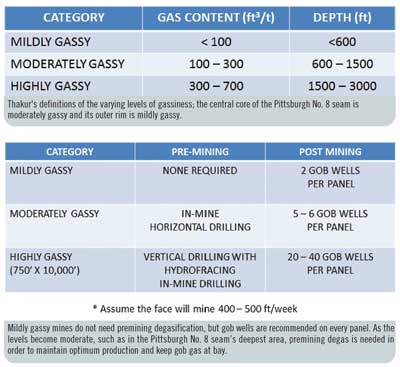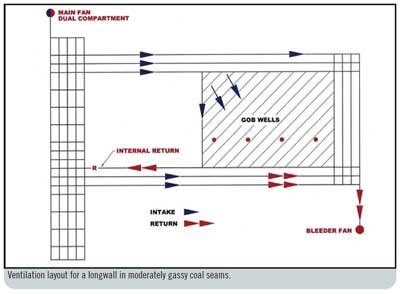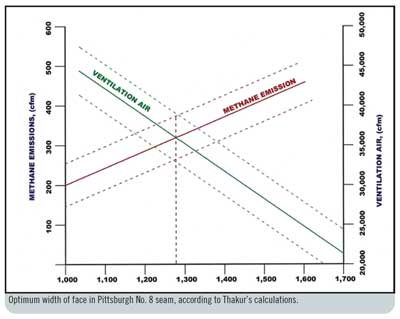The Pittsburgh No. 8 seam: throughout history, one of the largest sources of domestic coal energy and also one of the worst regions for gas-related accidents. However, largely as a result of those events, it is also the heart of some of the world’s best degasification resources, technology and research. Much of that is being used domestically and internationally to keep mines safe and allow miners to continue to go home each day.
“Coal is what we’ve got; we need to build on what we’ve got,” said Dr. Pramod Thakur, self-proclaimed father of coalbed methane degasification and four-decade industry veteran who is one of today’s top sources for everything tied to gas ventilation.
“[But] we need to degas mines, make sure mines are safe. You can’t put a price on somebody’s life.”
While the evolution of longwall mining has brought great strides in efficiency, production and safety, as technology has progressed, longwall panels across the nation have increased in dimension and are now wider than they’ve ever been. Panels that began at a modest 300 or 400 feet are now on average more than 1,500 ft wide , and the Pittsburgh No. 8 seam is at the center of that growth with the nation’s largest concentration of longwall faces.
At the same time, the Pittsburgh No. 8 seam is also among the gassiest coal regions, which has left a perfect storm of sorts for longwall operators seeking to get the most from their mines.
Coal gas’ go-to expert — the Pennsyl-vania State University-educated Thakur developed many coal seam degasification techniques including in-mine horizontal drilling, vertical gob wells and massive hydraulic fracking of coal seams — feels that, in this age of super-wide longwalls, there is such a thing as an optimum face width, ventilation layout and degasification plan.
IMPORTANCE OF DEGASIFICATION
There is no doubt that knowledge of gas, and in this case the removal of it, is valuable in many aspects. For mines, and longwalls especially, production at these highly profitable operations can increase exponentially and, in turn, lower overall costs for the mine tremendously. Over time, that equates to millions of dollars for a mining operation and, in turn, their parent company. Add in greater safety for the mine’s workers, and it is a perfect storm of another, more positive kind.
During June 2015, there were 47 active longwalls, more than a quarter of which were owned by Murray Energy Corp. (MEC); the Ohio-based miner itself produces about 90 million tons annually. CONSOL Energy, former owner of some of those mines, had six remaining longwalls in its portfolio at the time. Arch Coal, Walter Energy and a handful of other miners rounded out the ownership circle.
In terms of location, West Virginia has 13, half of which are MEC longwalls. Pennsylvania, also core territory for the Pittsburgh No. 8, has eight of those shearers cutting panels. Both states contain the deepest area of the seam, and as such, serve as home to a vast majority of these faces.
Those deep seams bring with them higher levels of gas. As seen in the above map, the deepest area averages 6 billion ft3 per section (defined as a square mile, or 640 acres). Even the areas of outcrop as the seam begins to fade, gas averages 2 billion cf per section. According to Thakur, total gas in place is 7 trillion ft3 across 6,000 square miles and 40 billion tons of coal.
“It (the region) is quite gassy,” he said. “Whenever the gas content goes up beyond 120 ft3/ton, you must degas, otherwise you are running a risk.”
 The primary impetus for longwall miners pushing for greater panel dimensions is an understandable one and one that is both cost- and safety-driven: it is simply safer, more productive and less expensive to have fewer longwall moves. There is also more complete recovery of in-situ reserves with a super-wide longwall, and wider panels allow more time for gate development.
The primary impetus for longwall miners pushing for greater panel dimensions is an understandable one and one that is both cost- and safety-driven: it is simply safer, more productive and less expensive to have fewer longwall moves. There is also more complete recovery of in-situ reserves with a super-wide longwall, and wider panels allow more time for gate development.
However, there are also several disadvantages to increasing panel dimensions, such as the need for hidden geologic anomalies, some of which can decrease seam height, as well as maintain adequate ventilation air to the tailgate. Increased gob emissions and floor heaves are areas of concern as well. Premining degasifications is needed, but with that comes a capital expense.
“My philosophy is all coal mines are gassy,” Thakur said. “If anyone tells you [their] seam’s not gassy, don’t believe it.”
He defines the varying levels of gassiness as one of three categories: mildly gassy, with less than 100 ft3/ton of gas content (less than 600 ft in depth); moderately gassy, with 100-300 ft3/ton of gas content (between 600-1,500 ft in depth); and highly gassy, with 300-700 ft3/ton of gas content (1,500 to 3,000 ft in depth). The central core of the Pittsburgh No. 8 seam is moderately gassy and its outer rim is mildly gassy (see chart to the right).
He noted that the mildly gassy mines, those with 75-80 ft3/ton, do not need pre-mining degasification, but gob wells are recommended on every panel. As the levels become moderate, such as those mines in the Pittsburgh seam’s deepest area, pre-mining degas is needed in order to maintain optimum production and keep gob gas at bay.
Highly gassy mines, including those in the Alabama coalfield, are very difficult to degas, but it has been done with success via vertical drilling and fracking initially, followed by in-mine horizontal drilling.
“Each longwall panel [may be] 10,000 ft, 500 ft wide, and may have 20-40 gob wells,” he said of the region. Each costs about $300,000, and mines must make money to defray the cost — which, by and large, they have done.
While there are two ways to go about the process, horizontal drilling from the surface or in-mine horizontal drilling, the former is by far the cheaper option. Thakur, in fact, estimated a 10:1 cost difference, though the impact is less if there is a way to market the gas and offset that expense. Additionally, fracking is not needed in the shallower seams with high permeability.
In the Pittsburgh No. 8 seam, the goal is generally not to market or do anything else with the gas; operators are much more concerned with getting the gas out and safely mine the best coal with the best rates.
In mines with higher permeability, where development can’t be done, development boreholes are drilled to degas ahead of mining, followed by another drilled across. A typical panel, thus, may have eight or nine settings. In these places, the boreholes will also increase in density as they will have more time to produce, he said.
“This strategy has worked very well. We [MEC] have recovered 50% of the gas,” an ideal goal for the Pittsburgh No. 8 seam.
“The Pittsburgh No. 8 seam is very peculiar. You never think you will recover 100% of gas; it will take 1,000 days, three years, to get 65% of this gas. If [a mine does] 50% in a year and a half, they’re doing damn good,” noting that most in-situ gas being recovered with this goal can be drained within six to 18 months.
 POST-MINING DEGASIFICATION
POST-MINING DEGASIFICATION
Premining is not the only concern as it relates to gas in this key region of coal country, many operations can also run into gas post-mining as the progression of longwall mining results in roof movement and, in some cases, floor heaves, and that gas must be handled as well, according to Thakur. There are two techniques to achieve that, including vertical gob wells and cross-measure boreholes, a European-based technology measure mainly used in smaller and slower moving longwalls.
“When the floor heaves, sometimes 25% of the gas in gob comes from the floor,” he said. “Many mines [in history] have had disasters because of this floor gas.”
In general, the wider the panel, the higher up it breaks. In one case from his experience, he confirmed gas production from up to 1,000 ft from the surface at a longwall with a 1,000-ft face. “When you plan degas of the gob, you have to allow for these things,” he added.
THE BOTTOM LINE
A typical longwall liberates 8 million ft3 of gas daily, and on average 55-60% of gas from the gob can be captured. Assuming bleeders are kept in the safe zone below 1.5%, and with bleeder air managing 3.2 million-4.4 million ft3/day, the ventilation air needed in such a scenario is 150,000 to 200,000 ft3 per minute (cfm). Gas emissions on the longwall face primarily depend on the gas content of de-gassed coal and the rate of mining (Thakur uses a rate of 70 ft/day), but it is clear that those ventilation figures are a tall order.
So, just how wide can a longwall face be in the Pittsburgh No. 8 seam and still mine safely? Thakur said that the criteria for an optimum face length/panel width are the tailgate’s total gas flow and ventilation air and a methane (CH4) concentration of below 1%, ideally 0.8%.
“Based on my experience, if you make it too long and you don’t have enough air…you may be legal, but go 6 in. up and you may not,” he said. “It’s very important to check; it can’t go unabated.”
 Using the gas layering index to determine one’s gas layering number (GLN) is important as well. With a typical degas emission of about 300 cfm at an average of 10 ft, one would need 39,000 cfm of air, a number, that some mines can’t achieve — a “tragedy,” according to Thakur, who recommends cutting down the face from 1,600 ft, in some cases, to a more manageable size. He also strongly stresses the use of an internal return with regulator.
Using the gas layering index to determine one’s gas layering number (GLN) is important as well. With a typical degas emission of about 300 cfm at an average of 10 ft, one would need 39,000 cfm of air, a number, that some mines can’t achieve — a “tragedy,” according to Thakur, who recommends cutting down the face from 1,600 ft, in some cases, to a more manageable size. He also strongly stresses the use of an internal return with regulator.
With faces at their current range of depths and length, the result is often less air and more emissions in tailgate. Fans are helpful to an extent, but a better financial selection for operations to make is degasification, which will cut down on quickly rising costs of powerful fans and ventilation plans focused on them.
As seen in the chart, Thakur offers an estimation of an optimum face width for the Pittsburgh No. 8 seam using methane emissions and total ventilation air; the seam, again, is considered to be moderately gassy. His general recommendations include a face length of 700 to 750 ft in highly gassy mines, 1,250 to 1,320 ft in moderately gassy mines and those classified as highly gassy can exceed 1,500 ft.
Another advantage to degasification, should an operator choose to collect and market it, is additional revenue to offset degassing and overall mining costs.
“You clean that gas, put in in a pipeline, you can make some money…even at today’s rates,” Thakur noted.
 Without question, however, whether or not a longwall mine chooses to sell its gas, he encourages that management listen to its technical experts, especially when many mines waste millions to find a result that matches the initial recommendation of said expert. Over the years, he said, he has watched many mines do just that.
Without question, however, whether or not a longwall mine chooses to sell its gas, he encourages that management listen to its technical experts, especially when many mines waste millions to find a result that matches the initial recommendation of said expert. Over the years, he said, he has watched many mines do just that.
“There’s a famous [movie] saying…‘a man gots to know his limitations.’ We all need to know our limitations,” Thakur said.
“Panels need to be brought down to this level. My message to you: we have the technology today to make sure that mines don’t blow up. People don’t need to die because of gas anymore.”
Note: This article is an adaptation of a presentation given by Murray Energy Corp. Coal Degasification Group Manager Dr. Pramod Thakur at the Longwall USA Exhibition and Conference held during June 2015.




